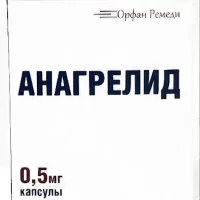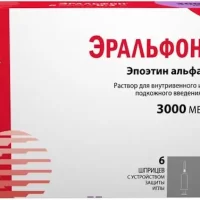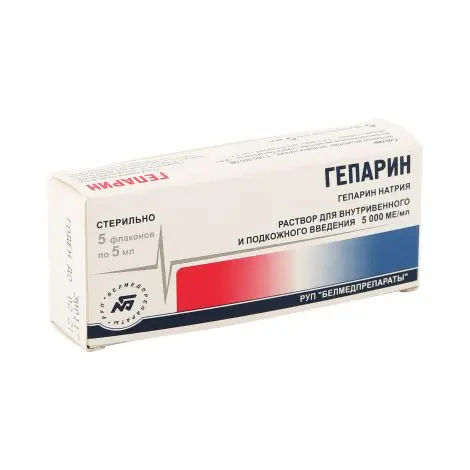Description
Calcium nadroparin Pharmacodynamics
Mechanism of Action
Calcium nadroparin is a low molecular weight heparin (LMWH) obtained by depolymerization from standard heparin. It is a glycosaminoglycan with an average molecular weight of approximately 4,300 daltons.
Calcium nadroparin exhibits a high ability to bind to the plasma protein antithrombin III (AT III). This binding leads to accelerated inhibition of factor Xa, which accounts for the high antithrombotic potential of calcium nadroparin.
Other mechanisms providing antithrombotic action of calcium nadroparin include activation of tissue factor conversion inhibitor (TFPI), activation of fibrinolysis by direct release of tissue plasminogen activator from endothelial cells and modification of blood rheological properties (decrease of blood viscosity and increase of membrane permeability of platelets and granulocytes).
Indications
Prevention of thromboembolic complications:
In general surgical and orthopedic interventions;
In patients with high risk of thrombosis (with acute respiratory failure and/or respiratory infection, and/or heart failure), who are on bed rest due to acute therapeutic pathology or hospitalized in intensive care units or intensive care units;
Treatment of moderate/severe pulmonary embolism or proximal deep vein thrombosis of the lower extremities;
Prevention of blood clotting during hemodialysis;
Treatment of unstable angina pectoris and myocardial infarction without Q-wave.
Contraindications
Hypersensitivity to calcium nadroparin or any other component of the drug;
A history of severe heparin-induced thrombocytopenia (HIT) type II caused by the use of unfractionated or low molecular weight heparin, or any thrombocytopenia caused by the use of calcium nadroparin;
thrombocytopenia in combination with a positive in vitro antiplatelet antibody test in the presence of calcium nadroparin (see section “Special Indications”);
signs of bleeding or increased risk of bleeding associated with impaired hemostasis, except for DIC, not caused by heparin;
organic lesions of organs prone to bleeding (e.g., acute gastric or duodenal ulcer);
intracranial hemorrhage;
acute infectious endocarditis;
Severe renal insufficiency (creatinine clearance less than 30 ml/min) in patients receiving calcium nadroparin for treatment of thromboembolism and venous thrombosis, unstable angina, and myocardial infarction without Q-wave
trauma or surgical interventions on the brain, spinal cord, or eyes;
local and regional anesthesia for elective surgery in patients receiving calcium nadroparin for treatment of pulmonary embolism, deep vein thrombosis, unstable angina, and myocardial infarction without Q-wave.
Dosage and administration
- Calcium nadroparin should be administered subcutaneously or intravenously bolus.
- Treatment of unstable angina and myocardial infarction without Q-wave: first administration – intravenously.
- Hemodialysis: injection into the arterial line of the extracorporeal hemodialysis circuit.
- Do not administer intramuscularly.
- Recommended doses.
- Prevention of thromboembolic complications.
- In general surgical procedures.
- The recommended dose of calcium nadroparin is 0.3 ml (2850 anti-Xa ME) subcutaneously 2-4 hours before surgery, then calcium nadroparin is administered once daily for the duration of thrombosis risk (but not less than 7 days) and until the patient is transferred to outpatient treatment.
- In orthopedic interventions
Calcium nadroparin is administered subcutaneously at a rate of 38 anti-Ha IU/kg weight, the dosage depends on the patient’s body weight (listed in Table 1 below), and may be increased up to 50% on the 4th postoperative day. The initial dose is administered 12 hours before surgery and the 2nd dose 12 hours after completion of surgery. Then calcium nadroparin continues to be used once a day for the entire period of risk of thrombosis until the patient is transferred to an outpatient regimen. The minimum period of therapy is 10 days. - Table 1. Dosing of calcium nadroparin in the prevention of thromboembolic complications during orthopedic interventions
- Patient body weight (kg) Dose of calcium nadroparin administered 12 hours before and 12 hours after surgery, then once a day until the 3rd day after surgery Dose of calcium nadroparin administered once a day starting on the 4th day after surgery
Volume, ml Anti-Cha ME Volume, ml Anti-Cha ME
< 50 0,2 1900 0,3 2850
50-69 0,3 2850 0,4 3800
≥ 70 0,4 3800 0,6 5700 - In patients at high risk of thrombosis (with acute respiratory failure and/or respiratory infection, and/or heart failure), on bed rest due to acute therapeutic pathology, or hospitalized in intensive care units or intensive care units
Calcium nadroparin is administered subcutaneously once daily. The dose depends on the patient’s body weight and is listed below in Table 2. Calcium nadroparin is used throughout the period of risk of thrombosis. - Table 2. Dosing of calcium nadroparin in the prevention of thromboembolic complications in patients at high risk of thrombosis
- Patient body weight (kg) Dose of calcium nadroparin administered once daily
Volume of calcium nadroparin, ml Anti-Kha ME
≤ 70 0,4 3800
> 70 0,6 5700 - For elderly patients, it is reasonable to reduce the dose to 0.3 mL (2,850 anti-Xa ME).
Treatment of moderate/severe pulmonary embolism or proximal deep vein thrombosis of the lower extremities - In the absence of contraindications, therapy with oral anticoagulants should be started as soon as possible. In the treatment of thromboembolism, calcium nadroparin therapy should be continued until target international normalized ratio (INR) values are achieved.
- Calcium nadroparin is administered subcutaneously twice daily (every 12 hours) for 10 days. The dose depends on the patient’s body weight and is shown in Table 3 below (at a rate of 86 anti-Xa IU/kg body weight).





